Mass Spectrometry Centre
Home to expert operators of a range of advanced mass spectrometers, including some of the most powerful instruments in Australasia.
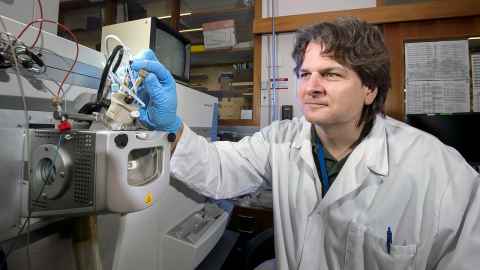
Equipment
- Sciex TripleTOF 6600 LC-MS/MS
- Bruker Solarix XR 7T FT-ICR
- Agilent 7700 ICP-MS
- Agilent 5977A GC-MS
- Agilent 5975C GC-MS
- Thermo ISQ GC-MS
- Agilent 6460C Triple Quadrupole
- Bruker micrOTOF-QII LC-MS/MS
- Agilent 5975C GC-MS (SCS)
- Thermo Exploris
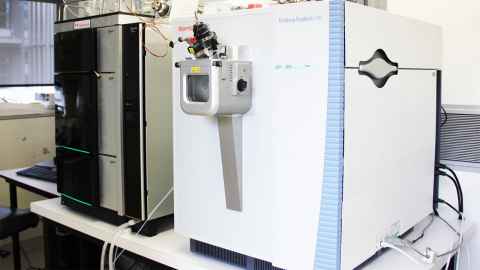
Sciex TripleTOF 6600 LC-MS/MS
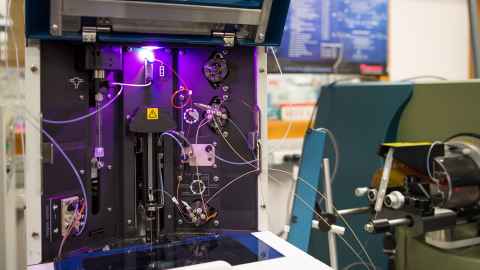
This nanoLC-MS/MS Q-TOF delivers high sensitivity, high acquisition speed and high-resolution MS and MS/MS spectra. Well suited to analysing highly complex proteomic samples, as well as simpler mixtures where accurate targeted quantitation is required.
Quantitation can be achieved by labelled (e.g. iTRAQ) label-free (e.g. SWATH/DIA) or MRM approaches.
Typical applications: Identifying and characterising proteins, and the relative quantitation of selected proteins or whole proteomes.
Specifications: Typical flowrate 300nl/min, injection volume 0.5-10ul, Resolution ~30,000 (both MS and MS/MS mode), MS/MS acquisition rate ~50Hz for IDA mode, up to 200Hz for targeted mode.
Bruker SolariX XR 7T FT-ICR
The SolariX XR 7T FT-ICR is the highest resolution mass spectrometer in New Zealand, capable of a wide array of experiments including: native mass spectrometry of large proteins and protein complexes, and 2D/3D analysis of thin tissue sections (MALDI imaging).
The ultra-high resolution, mass accuracy, and sensitivity allow accurate determination of large proteins/protein complexes, lipids, metabolites, proteins in biological tissues, or identification of low abundant species in a complex mixture.
Typical applications: Accurate MW determination of proteins or small molecules, analysis of protein complexes, gas phase experiments using dual channel emitters, MALDI imaging of biological tissues.
Specifications: MALDI or infusion ESI interface, resolution up to 1,000,000 at m/z 400, and “Coming soon”: Rapid reaction monitoring for Hydrogen/Deuterium Exchange-Mass Spectrometry to determine the solution phase structure of biomolecules.
Agilent 7700 ICP-MS
The Agilent 7700 Inductively Coupled Plasma Mass Spectrometry (ICP-MS) is suitable for trace elemental analysis of several materials, including geological, biological, metallurgic, agricultural and environmental samples.
Its main advantage is that it can rapidly analyse a large number of elements in a single analytical run. Samples can be analysed in either a liquid (solution ICP-MS) or solid form (laser ablation; LA-ICP-MS; using the ASI Resolution 193nm laser).
The typical lower detection limits for most elements are in the parts per trillion range, however this dependent on the analysis mode and sample matrix. The ICP-MS is equipped with collision cell technology (He) for reduction and elimination of polyatomic interferences on difficult to analyse elements.
In addition to elemental analysis, the ICP-MS can be used for the determination of isotopic ratios of selected elements to a precision of ±0.2% for isotopic tracing and uranium-lead dating of minerals from rocks such as zircon.
Agilent 5977A, 5975C and Thermo ISQ GC-MS
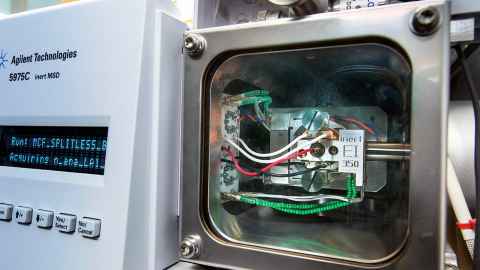
These instruments are used primarily for metabolite profiling. Various types of derivatisation are employed to enable the analysis of organic acids, amino acids, fatty acids, sugars and other volatile compounds.
Solid Phase Micro Extraction (SPME) is an option to analyse non-derivatised volatiles.
Typical applications: metabolomics profiling of extracts from biological samples, mainly with methyl chloroformate derivatisation for general work, but also TMS and methyl esterification for other classes of analyte, e.g. fatty acid methyl esters.
Data analysis is supported by access to the Wiley NIST 2017 Mass Spectral Database (>1 million EI spectra), MassHunter, ChemStation, AMDIS, NIST MS, MassOmics, R and Python.
Agilent 6460C Triple Quadrupole
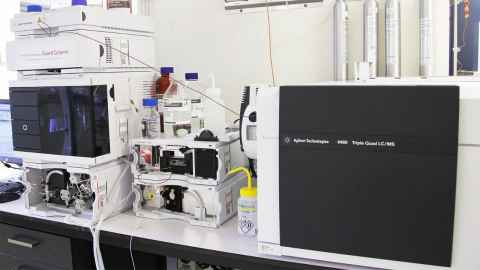
The Agilent 6460 Triple Quadrupole LCMS combines the separation power of HPLC with the detection power (i.e. sensitivity and selectivity) of a triple quadrupole instrument for targeted analysis of small molecules in complex samples.
The Agilent Jet Stream technology uses super-heated nitrogen to improve ion generation and desolvation, which leads to greater signal and reduced noise. Fast multiple reaction monitoring (MRM) speeds allow for analysis of over 100 overlapping compounds in a given retention time window.
Triggered MRM (tMRM) combines fast and sensitive MRM quantitation with the generation of a product ion spectrum for library searching and compound screening and confirmation.
Specifications: Mass Range: 5-2,000 m/z, Mass Resolution: 0.7 amu (FWHM).
Bruker micrOTOF-QII LC-MS/MS
The Bruker micrOTOF-QII high-resolution mass spectrometer can be used for the identification of volatile small molecules, peptides and proteins.
This instrument is equipped with ESI, Nanospray and APCI ionization capabilities. Samples may be directly infused, or introduced through the Dionex HPLC or Advion NanoMate interface.
Specifications: Mass resolution to 17,500, over the range 50 – 20,000 m/z, mass accuracy of within 4 ppm.
Agilent 5975C GC-MS (SCS)
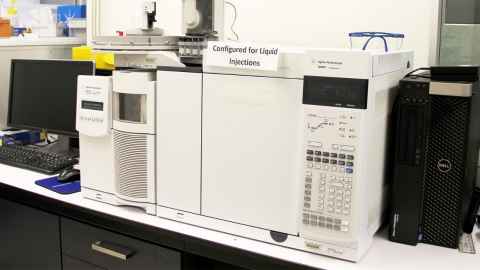
The Agilent 7890A gas chromatograph at the School of Chemical Sciences (SCS), coupled with an Agilent 5975C mass spectrometer, can be used for the analysis of fatty acids, sterols, alkanes, aldehydes, amines, sugars, sugar alcohols and amino-sugars (mono, di and tri-saccharides), polycyclic aromatic hydrocarbons (PAH), volatile compounds – fragrances, odours, fuel residues, illicit drugs, phthalates, plasticisers, silicones and unknown compounds.
It is currently configured with a non-polar (5-MS) column and an EI source, with the option of other polar columns, as well as a CI source. It has an Agilent autosampler and the NIST08 mass spectral library.
Data analysis is supported by access to MassHunter, ChemStation, AMDIS, NIST MS softwares. Our services include training for students in operation and maintenance, method development and optimisation.
How we can help you
Project Design/method development
Our experienced team members are available to discuss the options and possibilities for your project, and help to guide your analysis in the right direction.
Costs
The various instruments available in this core have individual pricing regimes. In some cases lower rates for self-service access are available.
Booking
Most of these instruments are booked through iLab. Users need to be a member of a lab within iLab, with access to funds, in order to lodge a request.
Sample requirements
These vary depending upon what instrument, and which type of analysis is under consideration. Contact the relevant person listed below to be sure that you have properly addressed the specific sample preparation requirements of your project.
Training requirements
Some mass spectrometers will have a self-use option, predicated on some training being undertaken in advance.
Data analysis
You can liaise with the relevant facility staff member to ensure that you are getting the most out of your dataset. Some data processing software is available through various virtual machines to allow remote data processing by users.
Related instrumentation
- BIRU operate a MALDI-TOF for Imaging MS work | Dr Gus Grey, Faculty of Medical and Health Sciences
- ACSRC operate QQQ and Q-TOF instrumentation | Dr Frederik Pruijn, Faculty of Medical and Health Sciences
- Engineering operate QQQ and GC-MS instrumentation | Dr Jishan Liu (QQQ) or Dr Patricia Cabedo Sanz (GC-MS) in the Faculty of Engineering
Other resources
- The University of Auckland Mass Spectrometry Hub (MaSH)
Our people
- General MS enquiries, LC-MS/MS enquiries | Martin Middleditch
- Bruker Solarix XR 7T FT-ICR | Dr Mark Agasid
- Agilent 7700 ICP-MS | Stuart Morrow
- GC-MS enquiries | Dr Jin Wang
- Bruker micrOTOF-QII, SCS GC-MS, Agilent 6460C Triple Quadrupole | Dr Githal Arachchige